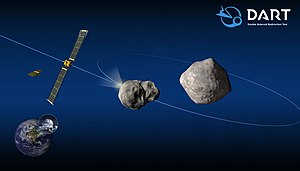
Back اختبار إعادة توجيه الكويكب المزدوج Arabic DART layihəsi Azerbaijani DART Bulgarian Test preusmjerenja dvostrukog asteroida BS Double Asteroid Redirection Test Catalan DART (sonda) Czech Double Asteroid Redirection Test German Double Asteroid Redirection Test Esperanto Double Asteroid Redirection Test Spanish DART Estonian
 Diagram of the DART spacecraft striking Dimorphos | |
| Names | DART |
|---|---|
| Mission type | Planetary defense mission |
| Operator | NASA / APL |
| COSPAR ID | 2021-110A |
| SATCAT no. | 49497 |
| Website | |
| Mission duration | 10 months and 1 day
|
| Spacecraft properties | |
| Spacecraft |
|
| Manufacturer | Applied Physics Laboratory of Johns Hopkins University |
| Launch mass |
|
| Dimensions |
|
| Power | 6.6 kW |
| Start of mission | |
| Launch date | 24 November 2021, 06:21:02 UTC[1] |
| Rocket | Falcon 9 Block 5, B1063.3 |
| Launch site | Vandenberg, SLC-4E |
| Contractor | SpaceX |
| Dimorphos impactor | |
| Impact date | 26 September 2022, 23:14 UTC[2][3] |
| Flyby of Didymos system | |
| Spacecraft component | LICIACube (deployed from DART) |
| Closest approach | 26 September 2022, ~23:17 UTC |
| Distance | 56.7 kilometres (35.2 mi) |
| Instruments | |
| Didymos Reconnaissance and Asteroid Camera for Optical navigation (DRACO) | |
Double Asteroid Redirection Test (DART) was a NASA space mission aimed at testing a method of planetary defense against near-Earth objects (NEOs).[4][5] It was designed to assess how much a spacecraft impact deflects an asteroid through its transfer of momentum when hitting the asteroid head-on.[6] The selected target asteroid, Dimorphos, is a minor-planet moon of the asteroid Didymos; neither asteroid poses an impact threat to Earth, but their joint characteristics made them an ideal benchmarking target. Launched on 24 November 2021, the DART spacecraft successfully collided with Dimorphos on 26 September 2022 at 23:14 UTC about 11 million kilometers (0.074 astronomical units; 29 lunar distances; 6.8 million miles) from Earth. The collision shortened Dimorphos' orbit by 32 minutes, greatly in excess of the pre-defined success threshold of 73 seconds.[7][8][9] DART's success in deflecting Dimorphos was due to the momentum transfer associated with the recoil of the ejected debris, which was substantially larger than that caused by the impact itself.[10][clarification needed]
DART was a joint project between NASA and the Johns Hopkins University Applied Physics Laboratory. The project was funded through NASA's Planetary Defense Coordination Office, managed by NASA's Planetary Missions Program Office at the Marshall Space Flight Center, and several NASA laboratories and offices provided technical support. The Italian Space Agency contributed LICIACube, a CubeSat which photographed the impact event, and other international partners, such as the European Space Agency (ESA), and Japan Aerospace Exploration Agency (JAXA), are contributing to related or subsequent projects.[11]
- ^ a b "DART". NASA Space Science Data Coordinated Archive. Retrieved 9 February 2023.
- ^ Cite error: The named reference
PressKitwas invoked but never defined (see the help page). - ^ Cite error: The named reference
spacecom-impact-timewas invoked but never defined (see the help page). - ^ Chang, Kenneth (27 September 2022). "What NASA's Crash into an Asteroid Looks Like – Astronomers on Earth – and a shoebox-size Italian spacecraft called LICIACube – captured the DART mission's successful strike on Dimorphos". The New York Times. Retrieved 28 September 2022.
- ^ Chang, Kenneth (25 September 2022). "NASA Is About to Crash into an Asteroid. Here's How to Watch – The DART mission has been flying to its target since launching last year. On Monday night, it will connect". The New York Times. Retrieved 26 September 2022.
- ^ "NASA's DART Mission Hits Asteroid in First-Ever Planetary Defense Test". NASA. 27 September 2022.
- ^ Chang, Kenneth (26 September 2022). "NASA Smashes into an Asteroid, Completing a Mission to Save a Future Day". The New York Times. Retrieved 27 September 2022.
- ^ Bardan, Roxana (11 October 2022). "NASA Confirms DART Mission Impact Changed Asteroid's Motion in Space". NASA. Retrieved 11 October 2022.
- ^ Strickland, Ashley (11 October 2022). "The DART mission successfully changed the motion of an asteroid". CNN. Retrieved 11 October 2022.
- ^ Cite error: The named reference
Nature March2023was invoked but never defined (see the help page). - ^ Keeter, Bill (7 September 2022). "DART Sets Sights on Asteroid Target". NASA. Retrieved 10 September 2022.; "SpaceX ready for first launch with NASA interplanetary mission". Spaceflight Now. 22 November 2021. Retrieved 24 November 2021.; "DART Launch Moves to Secondary Window". NASA. 17 February 2021. Retrieved 24 November 2021.
 This article incorporates text from this source, which is in the public domain.; "Live: NASA to crash spacecraft into asteroid in trial to protect Earth from collisions". ABC News. 26 September 2022. Retrieved 26 September 2022.
This article incorporates text from this source, which is in the public domain.; "Live: NASA to crash spacecraft into asteroid in trial to protect Earth from collisions". ABC News. 26 September 2022. Retrieved 26 September 2022.
© MMXXIII Rich X Search. We shall prevail. All rights reserved. Rich X Search